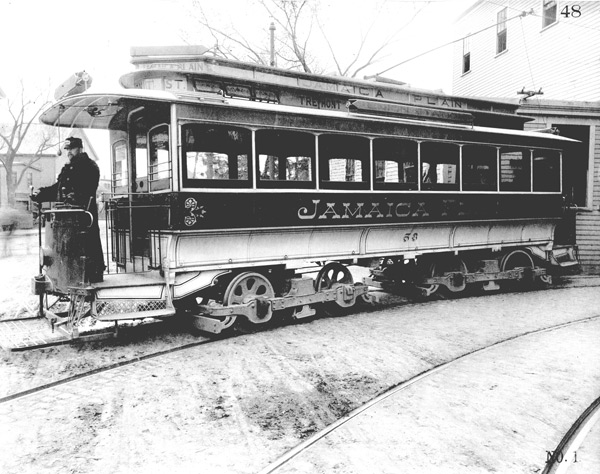
This open-end car and engineer pose in front of the Forest Hills carhouse (which would later become the Jamaica Loop) about 1896. By 1905, all cars were enclosed. An enlargement showing a better view of the conductor is shown on the next page.

The engineer of this open-end car poses in front of the Forest Hills carhouse (which would later become the Jamaica Loop) about 1896. By 1905, all cars were enclosed.

This completely open-style car was used during the hot summer months. The destination of this car is shown on the placard on the roof as UNION STATION VIA POST OFFICE SQ.
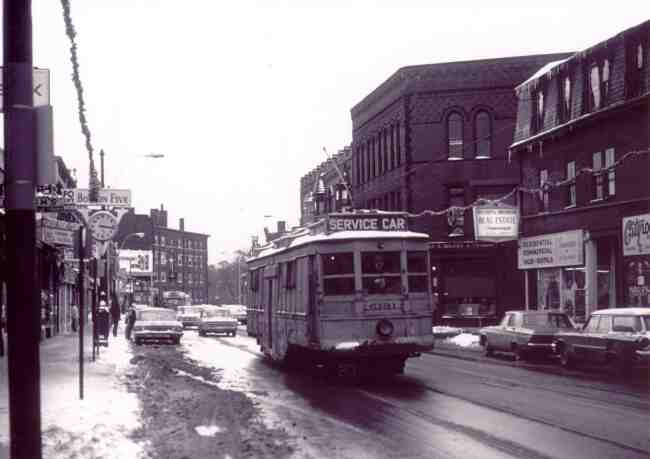
In this 1970 view of Centre Street, a 1940s-era trolley, in use as a maintenance vehicle, passes Boston Five Bank on the left and Burroughs Street on the right. Note the "Ask Mr. Fowler" sign (the business is currently in another location on Centre St.). Photographs in this collection are courtesy of Frank Norton and Joe Testagrose.
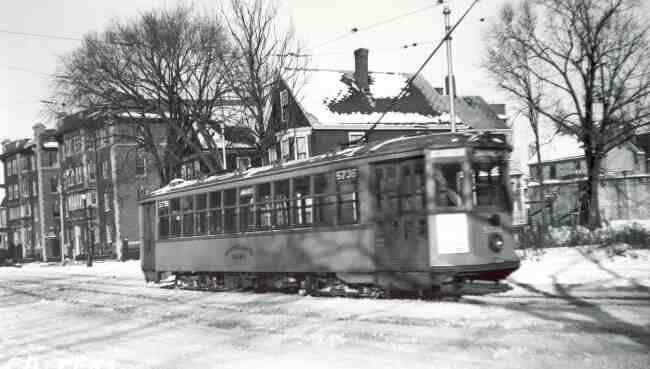
Boston Elevated trolley #5736 is shown in this 1938 photo on South Street. St. Mark Street is on the right while the Arborway is directly to the left of the trolley.

A trolley on South Huntington Ave. in 1942.
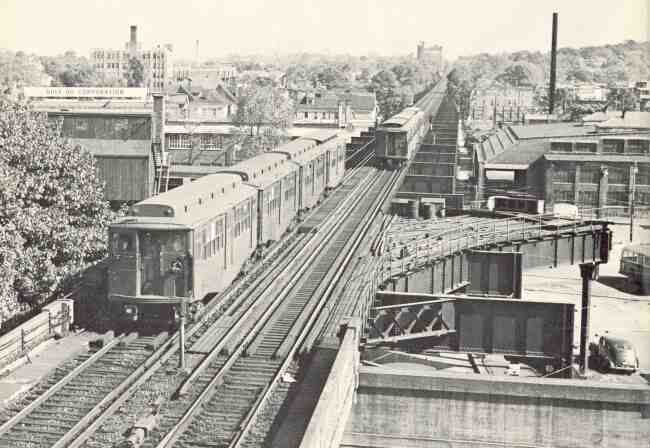
Trains traveling on Washington Street in 1953 can be seen passing the Arborway yard on the right. The Gulf Corporation building and the Boston Gas Company building can be seen to the left. In the far distance is the original Franklin Brewing Co. building.

A trolley turning from South Street towards Forest Hills Station in 1960.

This 1964 South Street photo shows trolley # 3220 near the Monument on its way to the Arborway trolley yard. Note the First National Grocery Store in the block of buildings to the left.

Trolley # 3328 is heading towards the Arborway on a quiet ride down South Street at the Monument in this 1965 photo. The Jamaica Drug Store at the corner of Eliot Street can be seen along with the Jamaica Driving School and Monument Fruit.
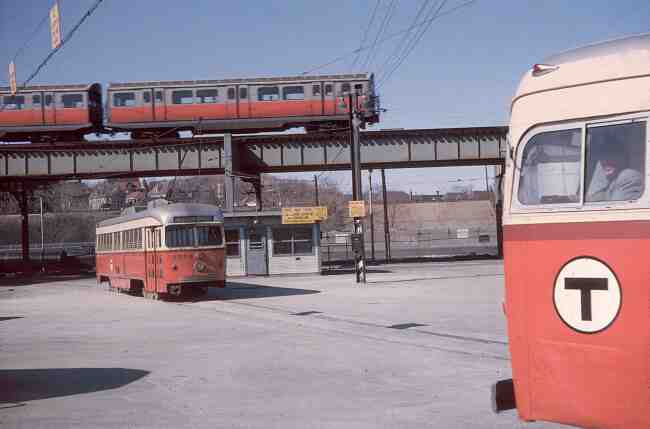
Here's an interesting scene captured in this 1966 Arborway Yard photo showing three different forms of public transportation offered by the MBTA. Notice the driver posing for the photographer on his trip out of the yard.
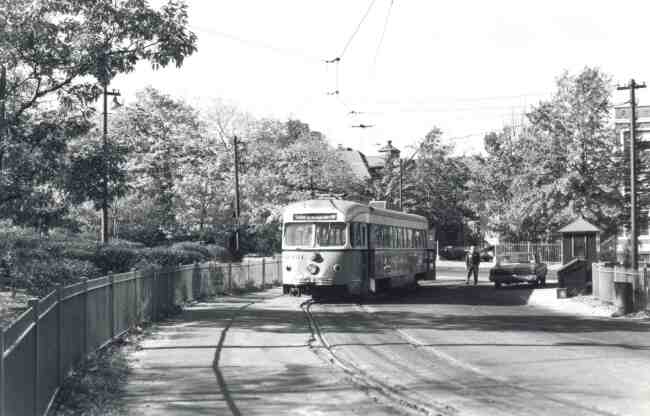
This photo at the Heath Street loop in 1966 shows a trolley driver waiting for his next trip. You can see the driver talking to the Inspector who made his rounds in an MBTA unmarked sedan.
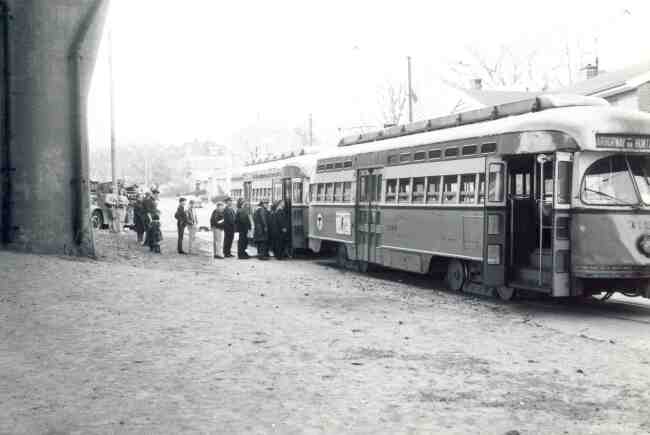
The electrical fire on trolley # 3210 causes quite a commotion at the bend of South Street under the Arborway overpass in this 1967 photo. The firemen and members of the MBTA are assessing the damage as passengers in the background wait to board. The beginning of the Arborway hill can be seen in the distance.

Trolley #3210 is shown in this 1967 photo after an electrical fire forced the evacuation of its passengers. The Arborway overpass is in the background.
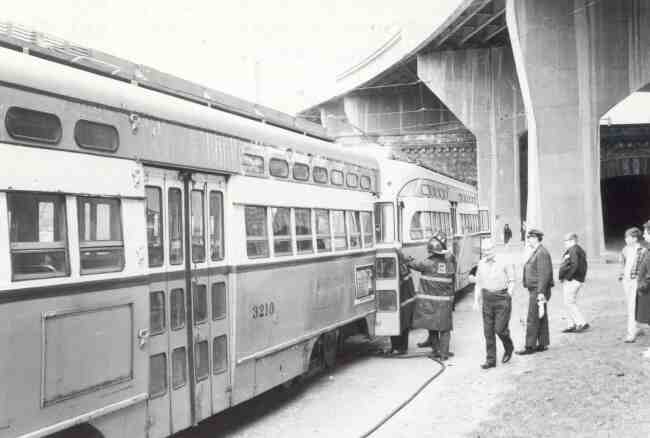
Trolley #3210 is shown in this 1967 photo after an electrical fire forced the evacuation of its passengers.

Trolley # 3326 is shown here in this 1967 photo at the Arborway yard getting a trolley wash. It appears that the machine goes around the trolley with a high pressure washing system.

Trolley # 3059 arrives back at the Arborway yard after a trip from Park Street in this 1967 photo. The MBTA employee vehicles can be seen in the background along with the overhead train tracks on Washington Street.

Centre Street is bustling in this 1967 photo taken near Burroughs Street in the heart of the business district. The thriving businesses that can be seen are the Jamaica Bowling Alley, the Galway House Restaurant, Sparkle Cleaners, Jax Discount Store, Harry’s Hardware Store, Hanlon’s Shoes, Roger’s Drug Store, and the Boston Five Cents Savings Bank with its ever present clock. A billboard displaying a brand new 1968 Chevrolet can be seen on top of the bowling alley building.

Centre Street in this 1967 photo appears to be relatively quiet. Trolley # 3298 is traveling towards Boylston Street and South Huntington Ave.
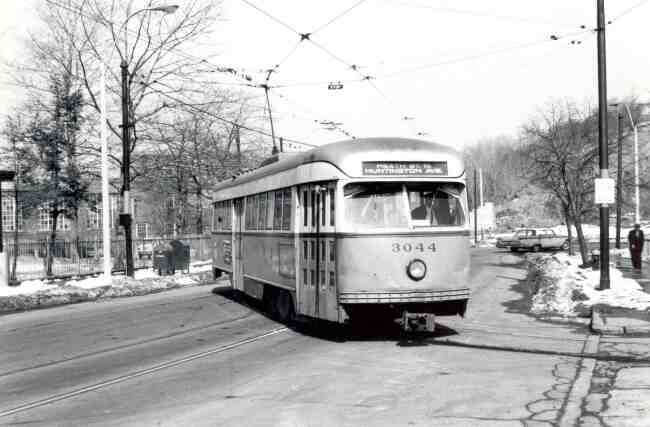
Trolley # 3044 is turning from South Huntington Avenue towards the Heath Street Loop in this 1967 photo. The Longwood Hospital's wrought iron fence can be seen to the left of the trolley.

Lonely trolley # 3211 can be seen approaching the Monument at South and Centre Streets in this 1967 photo after a snow storm.

Trolley # 3220 sits vacant at the Arborway yard on Washington St. in this 1968 photo. The ad on the side of the trolley is for Victor Coffee.
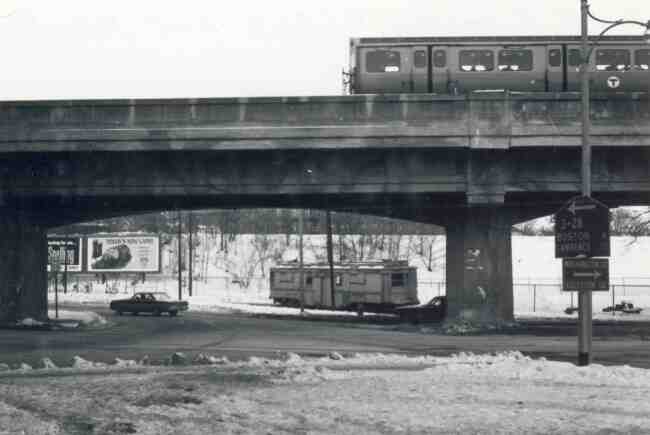
A service trolley heads toward South Street. The overhead train leaves Forest Hills Station on its way to Boston in this 1968 photo taken at the Washington Street rotary. The top street sign points toward Route 3-28 and reads Boston 4 and Lawrence 33. The bottom sign reads Washington Street and Egleston Square.
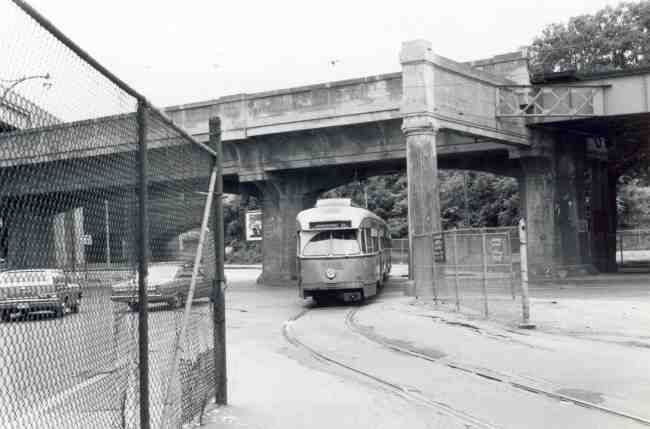
This 1968 photo shows a trolley returning to the Arborway yard while passing under the train structure on Washington Street.

Trolley # 3313 enters the Heath Street Loop during this 1968 photo op. Longwood Hospital can be seen behind the trolley.

Trolley # 3313 is the lead car of this three-car convoy photo taken at the Heath Street Loop on South Huntington Ave. in 1968. A portion of the Jamaica Plain Veterans Hospital can be seen to the left of the photo.
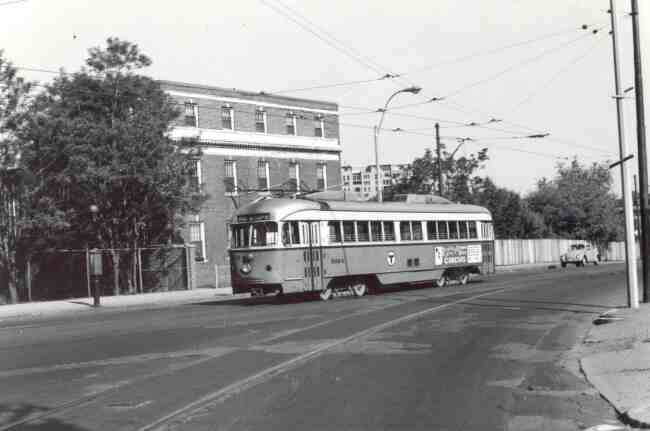
Trolley # 3324 travels on South Huntington Ave. near the Heath Street Loop in this 1968 photo. The Ringling Bros. Circus is being advertised on the side of the trolley.
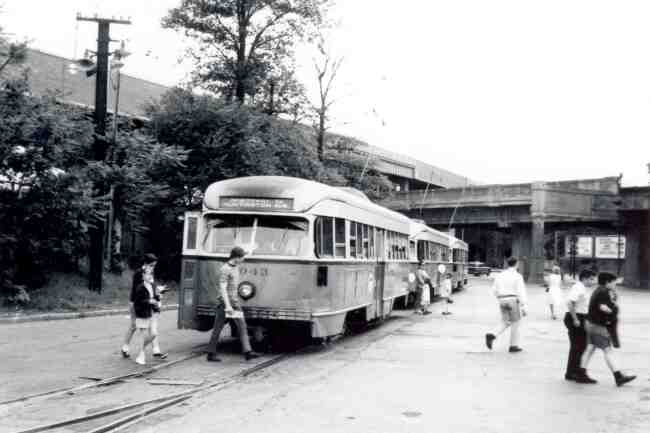
Passengers are shown making their way across the tracks in front of trolley # 3043 on its return trip from Park Street in this 1969 photo taken at the Arborway station.

Trolley # 3046 winds its way down Centre Street in this 1969 photo. The Thrift Shop of Boston along with Centre Seafood can be seen to the right. The Donnelly advertising sign is displaying a Delco car battery ad.
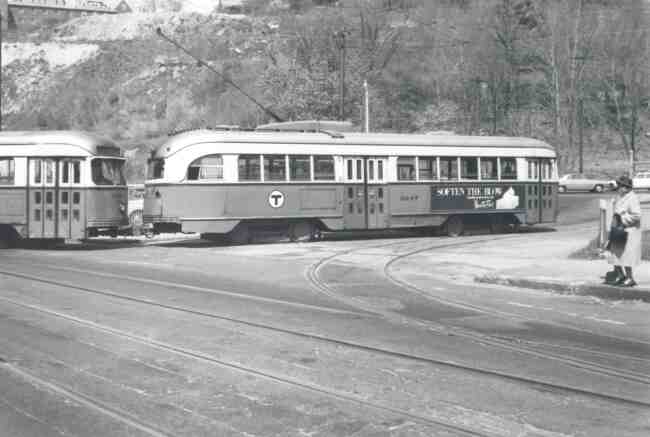
Trolley # 3047 turns into the Heath Street Loop on South Huntington Ave. in this 1969 photo.

Trolley # 3065 travels on South Huntington Ave. near the Longwood Hospital in this 1969 photo. The New England Baptist Hospital on Parker Hill Street in Roxbury can be seen high on the hill.

Trolley # 3047 & # 3210 converge in front of the Longwood Hospital on South Huntington Ave. in this 1969 photo. The New England Baptist Hospital can be seen high on the hill located on Parker Hill Street in Roxbury.

Trolley # 3329 travels on South Huntington Ave. on its way to Northeastern University on Huntington Ave. The VA Hospital towers to the right of the photo.

Trolley # 3327 travels up Washington Street on its way into the Arborway yard in this 1969 photo. McAulay Aluminum Doors and Windows storefront can be seen in the first floor of a converted house.

Trolley # 3323 begins its entrance into the Arborway trolley yard in this 1969 photo taken on Washington Street. One of the businesses that can be seen is John McAulay Aluminum Doors and Windows.

Washington Street near the Arborway MBTA yard seems almost deserted in this 1969 photo. The nice looking Ford Sedan with the number plate 55656 is being followed by a Boston Gas Company service van.

The Cleary Square bus is getting ready to depart from the Arborway yard in this 1970 photo.
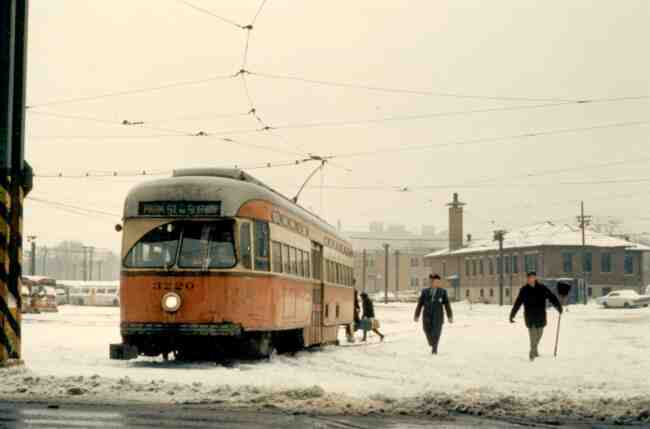
Trolley # 3220 seems to be waiting for some assistance from the MBTA Starter (in uniform) and his assistant (with the shovel) after a snow storm in this 1970 photo taken at the Arborway yard.

Trolley # 3046 is heading towards Park Street in this 1970 photo on Centre Street at the corner of Seaverns Ave. Some of the thriving businesses shown are the First National Bank, Jones Camera Shop, Helen's Donut Shop, The Edison Store, Hanlon Shoes, F. W. Woolworth, Hailer's Drug Store, Karsh Jewelers, Harry's Hardware, and the Publix Market.

An MBTA bus travels down Centre Street towards Eliot Street in this 1970 photo. The Allied Wallpaper Co. and Mullen's Bakery are directly across from Thomas Street.

Trolley # 3322 winds its way up a very busy Centre Street during this 1970 photo on its way to Park Street Station. Rogers Drugs can be seen on the corner of Burroughs Street, along with the sign for Hanlon's Shoes which was located up a steep stairway to the second level of the Burroughs building.

Trolley # 3046 passes the Mary E. Curley School on Centre Street in this 1970 photo.

Trolley # 3065 is traveling on Centre Street at Thomas Street in this 1970 photo. The businesses in view are Allied Wallpaper, Mullen's Bakery, Nu Way Shoes, and the Brigham's Ice Cream Shop.

Passengers can be seen boarding the train at Green Street Station on Washington Street in this 1970 photo.

The morning commuter train from Green Street Station seems pretty lively in this 1970 photo as they depart for Boston and beyond.

Trolley # 3328 travels down Centre Street at Seaverns Ave. on the way to the Arborway in this 1971 photo. Al's Barber Shop, Congress Cleaners, Jamaica Fruit Center, and Piece O' Pizza were all thriving businesses at the time.

Trolley # 3324 can be seen picking up passengers on a nicely tree-lined section of South Huntington Avenue at Bynner Street in this 1971 photo.

Park Street bound trolley # 3052 can be seen traveling on South Huntington Avenue near Perkins Street in this 1971 photo.

The Monument and First Church can be seen towering over trolley # 3205 as it travels on South Street near Bardwell Street in this 1971 photo. The Jamaica Drug Store can be seen in the distance at Eliot & Centre Streets.

Trolley # 3326 can be seen traveling between Saint Joseph St. and Jamaica St. in front of Saint Thomas Aquinas Church in this 1971 photo.
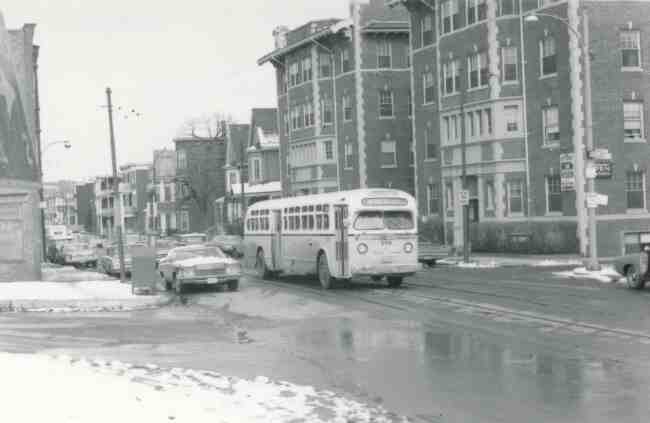
Bus # 2119 is heading towards Wren Street in Roslindale as shown in this 1971 photo taken on South Street near Mark Street and the Arborway.

The MBTA trains can be seen traveling over Washington Street near Green Street Station in this 1971 photo. The Sintered Metals, Inc. building can be seen under the train structures.

The MBTA trains are seen stored at the Forest Hills station in this 1972 photo.

Trolley # 3047 travels cautiously towards construction work being done on South Street near Bardwell Street in this 1976 photo. The Cla-Mar Beauty Culture shop can be seen along with the sidewalk supervisors observing all of the activity.

Well photographed older trolley # 5734 shares the spotlight with trolley # 3229 in this Arborway photo taken in 1979.
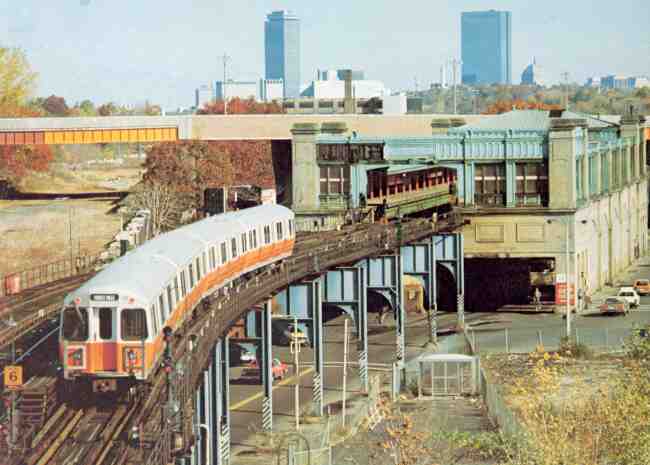
The Orange Line MBTA train reaches the end of the line at Forest Hills in this 1980s photo. The Arborway overpass can be seen along with the distant views of the Prudential and John Hancock buildings.

Twin Orange line trains can be seen berthed at the Forest Hills station in this 1983 photo.

This vintage Boston Elevated trolley # 5734 makes its way onto South Huntington Ave. during this 1985 photo.

This East Walpole car operated on the Old Colony St. Railroad and would normally be stored in Westwood. In this view, ca. 1897, the car is shown far from home in the yard of the Forest Hills carhouse. It was likely being stored here during off-peak hours due to shortage of parking spaces in Westwood.

A green line trolley heads out South Huntington Ave. having just passed the VA Hospital. October 29, 1956. An ad for Suffolk Downs appears on the side of the car.

A "Barrerel Car" serving West Roxbury and Roslindale. Note the cow-catcher on the front of the car. To the right, the rear of a horse drawn buggy can be seen. ca. 1897. This type of car was designed to be completely open in the summer and closed in the winter.
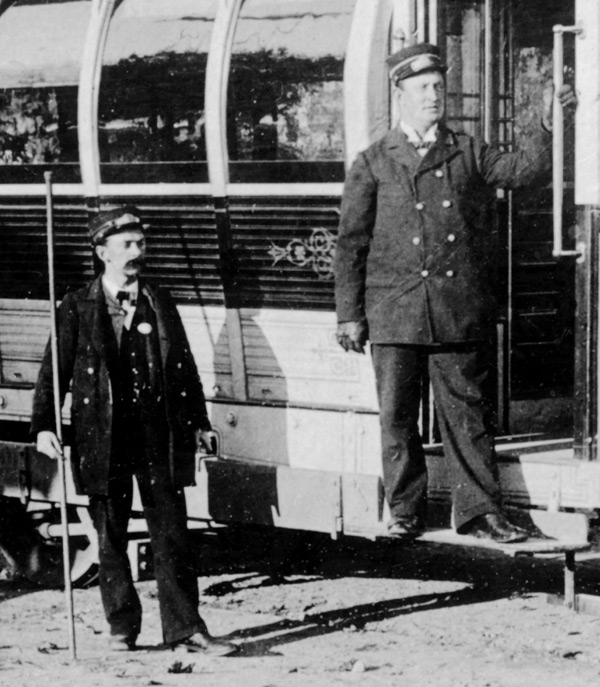
Enlargement of "Barrerel Car" serving West Roxbury and Roslindale.

The Barrerel Car #40 serving West Roxbury and Roslindale shown here previously although with a different crew ca. 1897. This type of car was designed to be completely open in the summer and closed in the winter.

Enlargement of The Barrel Car #40.

This "Snake Car" was also called "Two rooms and a Bath" and was cobbled together around 1914 by combining two older-style cars. Operated with one crew, it doubled the capacity of cars operated at the time. The "Snake Car" was produced in two sizes; the 4200 shown here was the largest type produced. The "Snake Car" design did not prove to be successful and they were soon removed from service and replaced with the new Semi-Convertible cars.
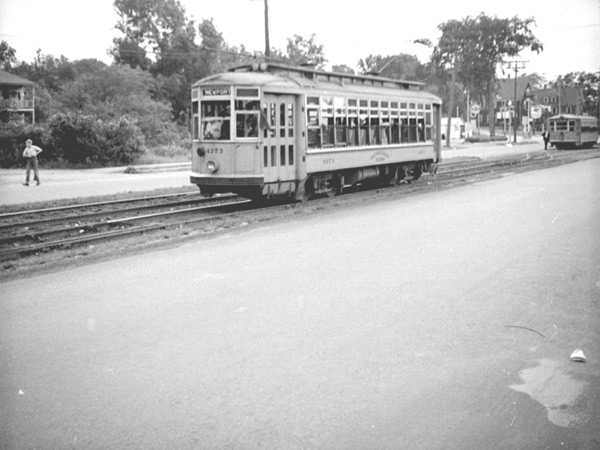
A 4373 type car built for the Boston-Lowell line and other long-haul lines in the Merrimac Valley. It was never commonly used in this area for standard fare service and is shown here on an excursion trip for trolley fans in 1941.

An interior view of a 4373 type trolley during an excursion on the Arborway line in 1941.
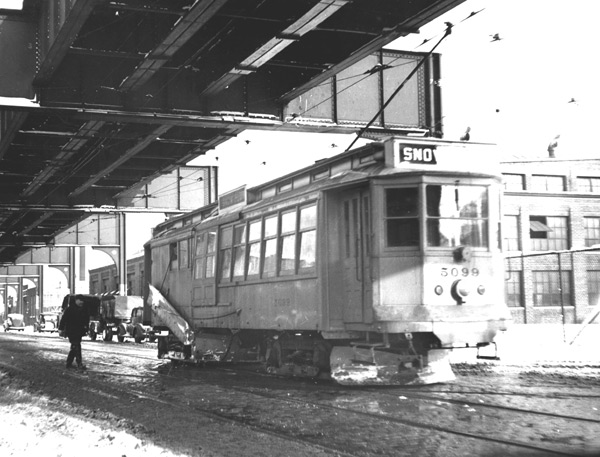
A car specially equipped to plow snow travels down Washington Street in December 1939. Now 96 years old, there are still two of these cars in service as of 2003! One is stored in Mattapan and another one at Riverside. These cars are nearly as heavy as modern Light Rail Vehicles so make great snow plows.

A car specially equipped to plow snow is shown here in 1941. Note the plow blades mounted on the side of the vehicle in the rear. When extended, this vehicle can plow a path about three times its own width.

A type 4 semi-convertible and a plow at Charles River Loop (now 36 bus) 1937.

A Type 4 car emerges from the Barry's Ledge siding. This siding, opposite Calvary Cemetery, led down to a stone crusher which loaded trolley dump cars with gravel.
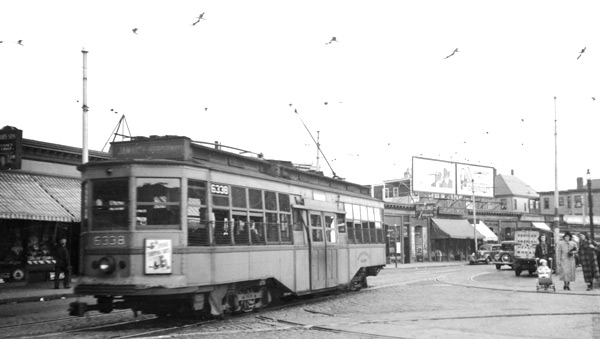
In this 1938 Jamaica Plain view, car 5338 travels down Centre Street. A tiny Atlantic & Pacific (A&P) grocery store can be seen with a large awning below the billboard. To the right, just to the left of the two women walking with a baby stroller, sits a truck parked at the curb with a sign on it for "Gentles Swedish Health Bread".
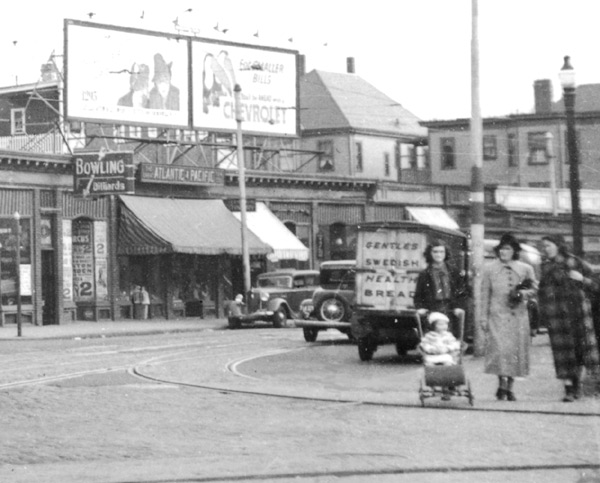
Enlargement. In this 1938 Jamaica Plain view, car 5338 travels down Centre Street. A tiny Atlantic & Pacific (A&P) grocery store can be seen with a large awning below the billboard. To the right, just to the left of the two women walking with a baby stroller, sits a truck parked at the curb with a sign, "Gentles Swedish Health Bread", afixed to the rear.
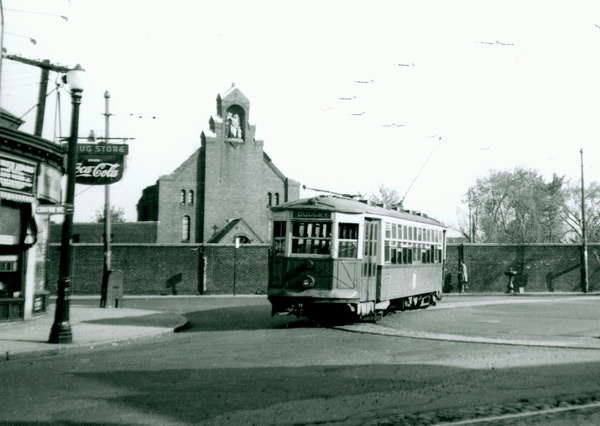
Car number 5690 makes the turnaround at Hyde Square in April of 1949. On the left can be seen a drugstore with a “Drink Coca-Cola” sign. Also on the left a sign reads “Watch Repair”. The “Centre St.” sign can also be seen clearly on the left.
A chapel can be seen behind the brick wall. Three school buildings operated by the House of Angel Guardians were also on the grounds. Photograph courtesy of Frank Cheney.
For maps and further history, see these two links:
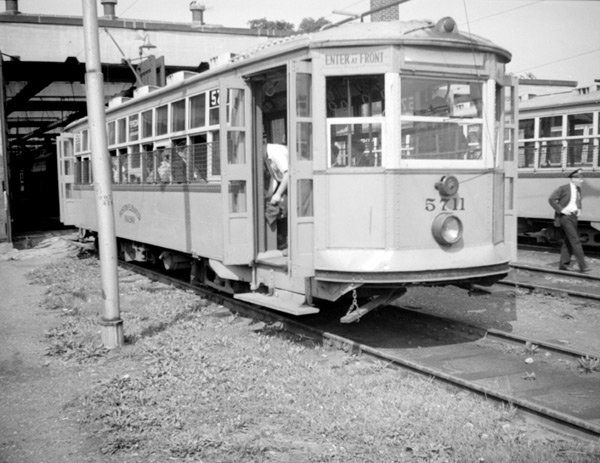
5711, seen in front of the Arborway carhouse is a 'Type 5'; a very light, but large car which saw heavy use all over the system. There were 471 of these cars and they are among the most often restored of all custom-made American streetcars. There is a 'Type 5' currently resident in Boylston Station. That car originally did its tour of duty on the Arborway line. November 7, 1941.

Car 5711 has taken on passengers at the Jamaica Station (Loop), where the old carhouse had been located, and prepares to begin its return trip. This photograph was taken in December 1939. Housing on Woodman Street, Ballard Way, and Jamaica Street can be seen in the background. Note the coblestone surface of South Street in the foreground. This was the end of the line from Dudley.

Car 5712 rounds the bend at Brigham Circle bound for Dudley Square. To the right of the car can be seen Kline Drug, Circle Restaurant, and the First National grocery store.
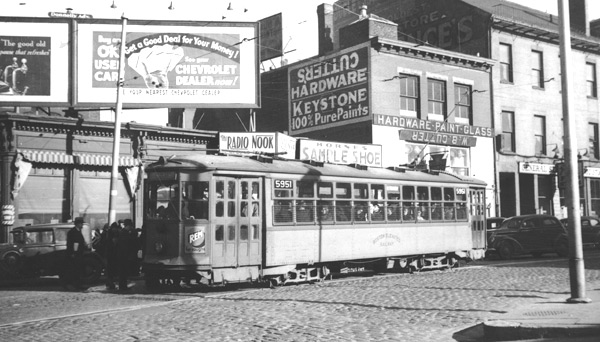
Guild Row in Dudley Square. Signs advertise The Radio Nook, Hornes Sample Shoes, and Cutter's Hardware. February 1938.
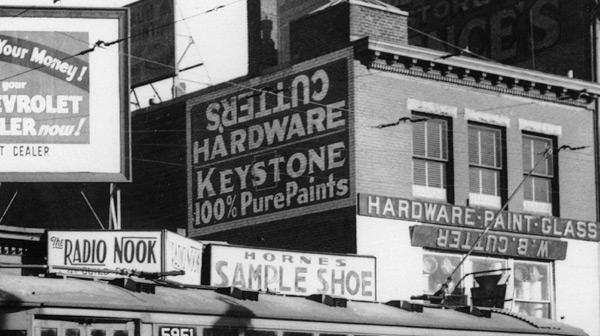
Detail of Dudley Square signs. February 1938.
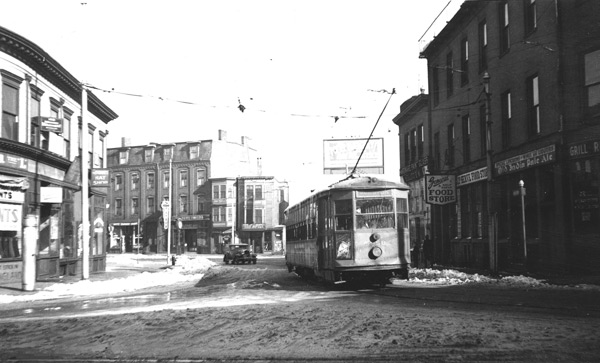
In this February 1938 view, car 5958 travels down Guild Row in Dudley Square. Although difficult to see without enlargement, signs in the square advertise "General Self Service Food Store", "Roxbury Hat Shop", "Roxbury Employment Center", "Roxbury Tavern", and "India Pale Ale." Other signs advertise a barber shop, auto supplies, and a key-making service.

Car 6297 carries an Egleston sign as it makes the bend in Jackson Square at Columbus and Centre Streets in March 1938. Note the "Pickwick Ale" billboard. The white building directly behind the trolley houses the Wm E. Mooney Club and Spencer's Lunch. These cars were the mainstay of the subway for years. They weighed half as much as a modern Light Rail Vehicle yet held the same number of passengers.
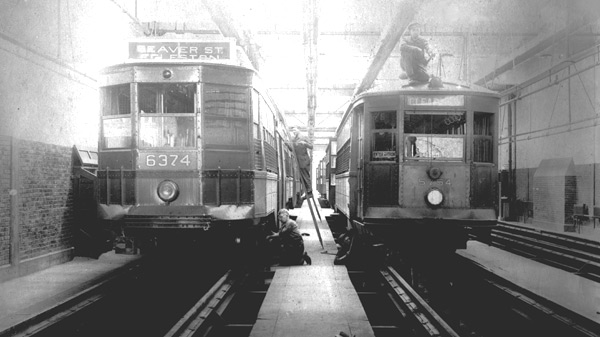
Two cars in the Jamaica Plain maintenance and repair facility. The car on the left served the Seaver Street Humbolt line providing service to Dudley Square and to Dorchester via Roxbury.

Car 6392, seen in November of 1938 at the point where the Arborway line turned onto the reservation and headed under the railroad into the Arborway yard. This type of car had a low center entrance that made it easy to climb up into to, but of limited use as subway car since the door was too low for the platform. When they were retired from passenger service, many stayed on and saw duty as sand or salt cars.
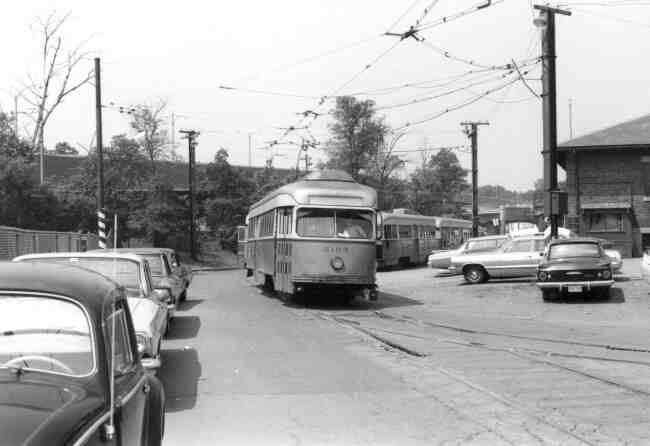
Trolley # 3103 winds its way around the rear of the Arborway yard in this 1960s photo. The vintage cars can be seen along with the view of the Arborway overpass.

Trolley # 3103 rests idly along side the Arborway MBTA office in this late 1960s photo.
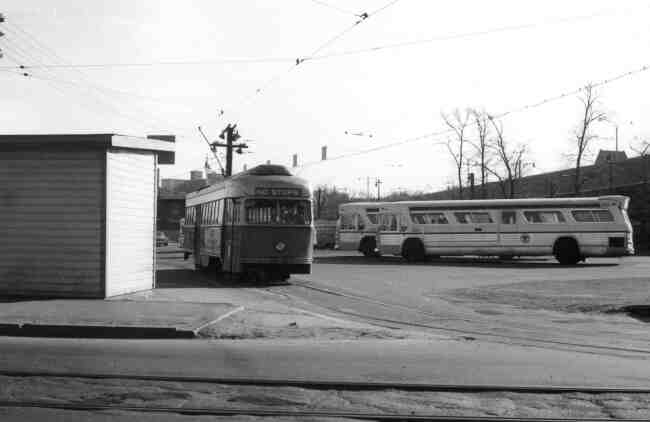
Trolley # 3229 is shown departing from the Arborway yard onto Washington Street in this late 1960s photo. The passenger shelter facility can be seen along with a few parked buses.

Trolley # 3217 waits for passengers at the exiting area of the Arborway yard on Washington Street in this late 1960s photo. The buses are located in the designated departure slots for later trips.

Trolley # 3206 makes its way into the Arborway yard on Washington Street in this late 1960s photo. The towering elevated structure hovers over the Kinney Vacuum building in the background.
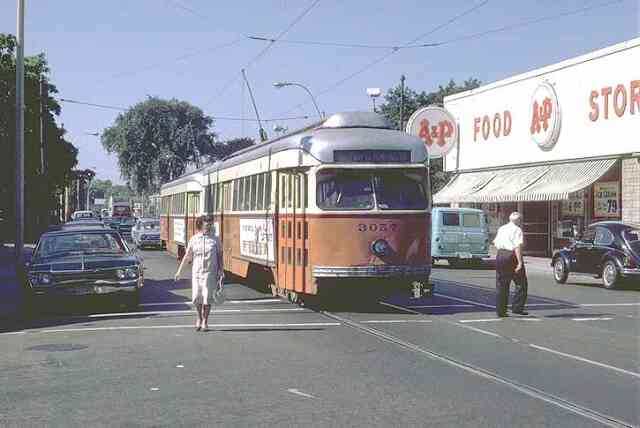
Passengers have just exited trolley # 3057 at Centre & Boylston Streets in this 1970 photo. Three observations can be made from this photo: 1) Housecoats were an acceptable form of dress; 2) Crosswalks were safe to use; 3) Ice Cream was selling for 79 cents at the local A&P store.

Passengers can be seen boarding trolley # 3322 on Centre Street near the Monument on this snowy day in 1967. Some of the businesses were the local First National Grocery Store, Monument Luncheonette, The Gift Box, The Telephone business office, and the Atlantic gas station on the corner of Thomas Street.

A trolley travels north on Centre Street near Harris Ave.

Centre & Burroughs Streets are the location for this 1960s photo showing trolley # 3043 on its journey to the Arborway. The local merchants were Boston Five Cent Savings Bank, Yumont Paint & Supply, Publix Market, F.W.Woolworth, and Rogers Drug Store.

Two trolleys approach Centre & Burroughs Streets in this 1969 photo. Rogers Drugs, O'Leary & Brennan Real Estate, Yumont Hardware, Publix Market, Boston Five Cents Savings Bank, and F. W. Woolworth were a few of the businesses at the time.

Two passengers board the Arborway bound trolley at Centre Street and Seaverns Ave. in this 1960s photo.
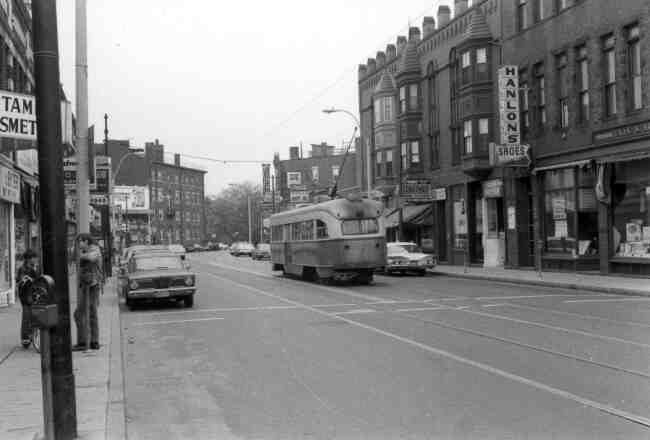
A lone trolley passes the Burroughs Building on its way down Centre Street towards the Arborway in this 1960 photo. Established businesses at the time were Rogers Drug Store, Frank’s DoubleWare Clothing, Barry’s Deli, Blanchard Liquors, and Galway House Restaurantand Hanlons Shoes.

Two men pass the First National Bank of Boston while walking on Centre Street at Seaverns Ave. in this 1960's photo. The trolley is heading towards the Arborway. The First Baptist Church steeple can be seen along with the Jamaica Plain Co Operative Bank, Hailer's Drug Store, Hanlon's Women Shoe Store, and Piece O' Pizza.

Service car # 6131 clears the tracks on Centre Street at Seaverns Ave. in this 1960's photo. The Christmas decorations can be seen strung overhead in the business district.
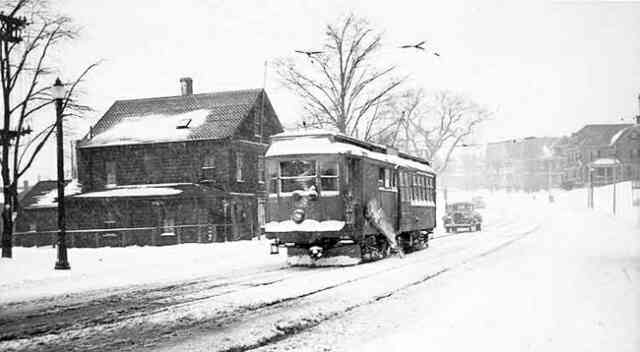
Trolley on wintry street run, 1965
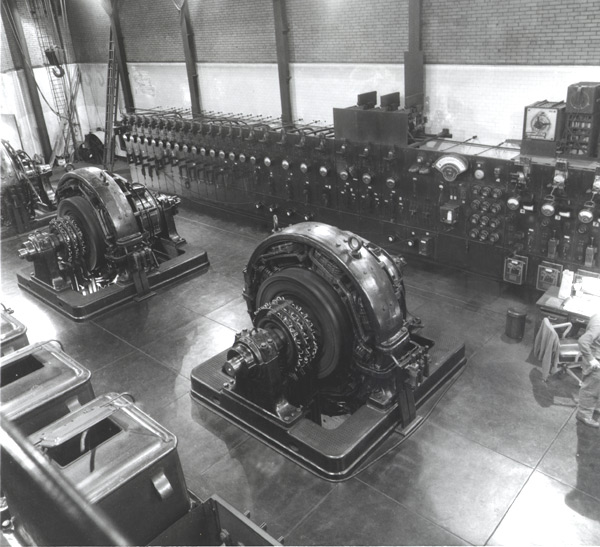
This striking view of the Egleston electrical substation was taken March 1974. The substation was responsible for the control, distribution, and monitoring of the high voltage power used by the elevated Orange line trains.
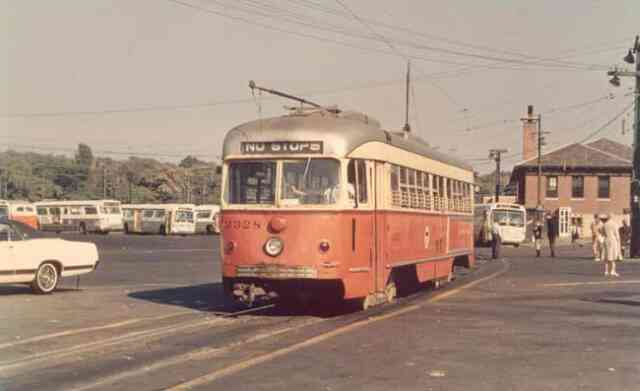
Trolley # 3328 waits for its next trip at the Arborway yard in this 1968 photo. Idle buses can be seen along with passenger waiting to board near the MBTA business office.
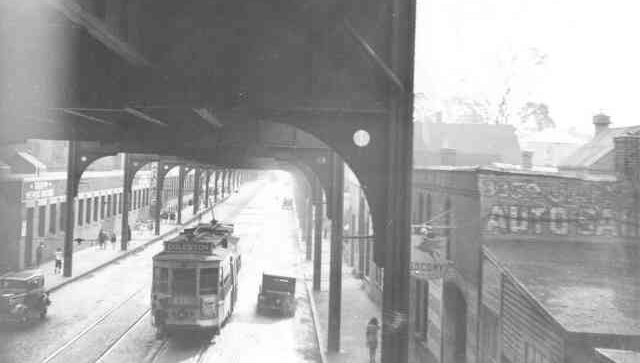
Trolley # 6392 travels down Washington Street past Green Street on its way to the Arborway in this 1938 photo. At the rear left of the trolley can be seen a boy hitching a ride on the trolley connecter. Tripp Metallic Packing is the building on the left. Socony auto repair is on the right.
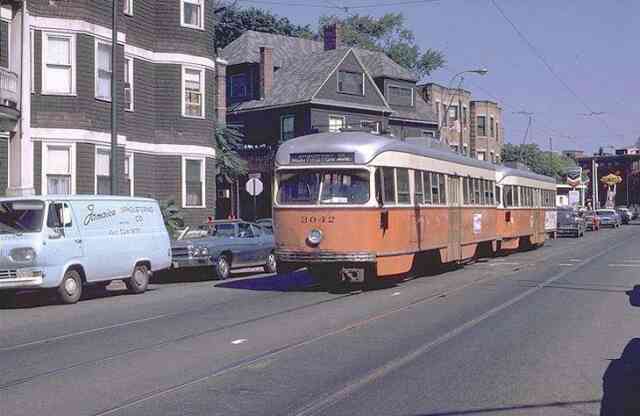
Centre Street at Grovenor Road in this 1970 photo shows Dr. Sumner Karp's building on the right and the Mobil Gas Station on the left.
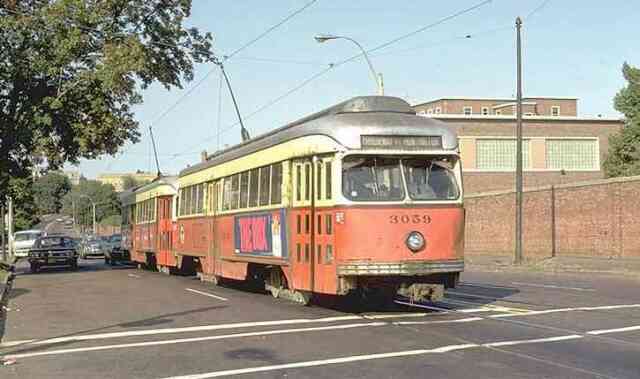
Trolley # 3059 travels on South Huntington Ave. near Perkins Street in this 1970 photo on its way to the Arborway. The massive MSPCA complex can be seen on the right.

Interior view of a "Barrell Car". 1897.

Enlargement. Interior view of a Barrell Car, 1897.
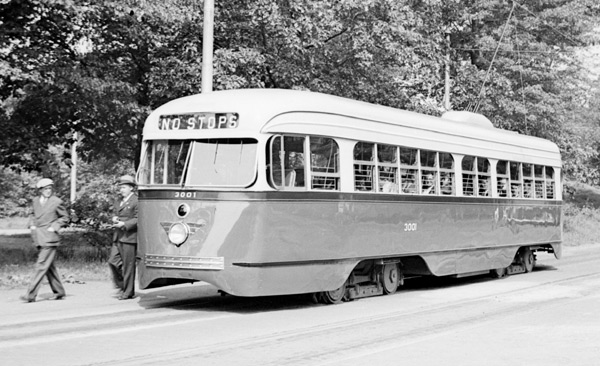
The Seaver Street Loop provided a turnaround for the line to Roxbury. The line crossed Seaver Street and entered Franklin Park were the Loop was located. This is a PCC style car, early 1950s.
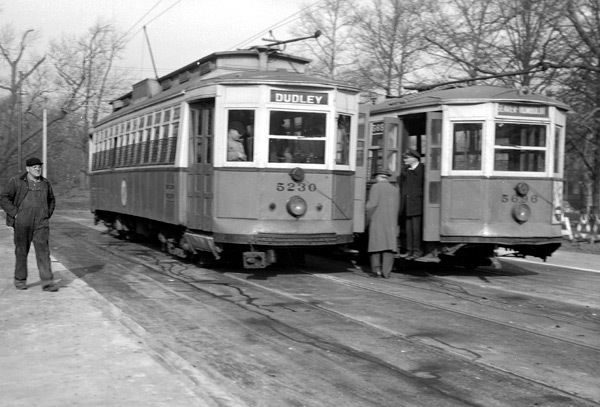
The Seaver Street Loop provided a turnaround for the line to Roxbury. The line crossed Seaver Street and entered Franklin Park were the Loop was located. 1949.
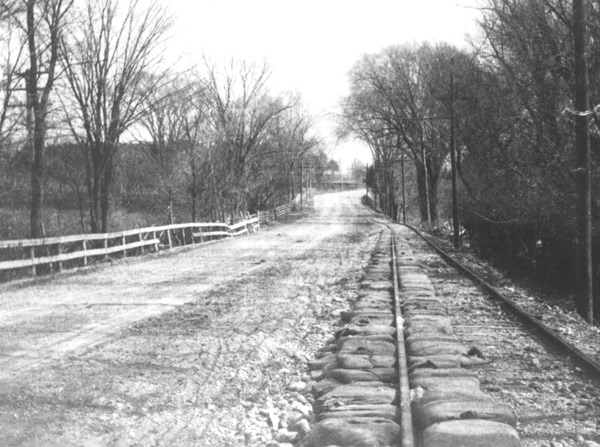
This photograph was labeled "South of Spring Street" and shows sandbags on the line to Needham, probably in Dedham. The sand bags were probably placed there to protect the track bed from flooding.
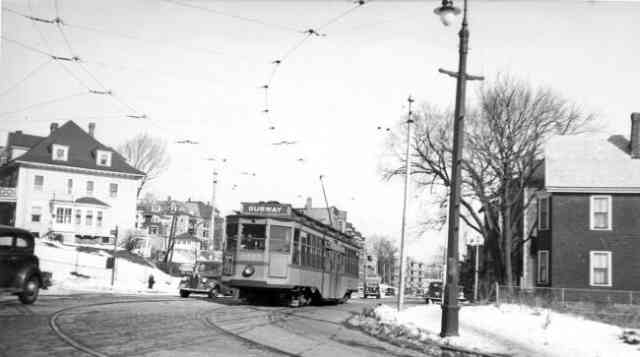
Trolley # 6290 winds its way onto South Street at the Arborway on a trip towards Centre Street and beyond. Many old cars can be seen in this great old 1939 photo.

A trolley heading to Park Street Station passes the Jamaica Plain Post # 76 American Legion building on South Street near the Arborway in this 1960s photo.

Brick apartment buildings can be seen on either side of South Street as trolley # 3326 passes St. Mark Street on its way towards Park Street station in this 1960s photo.

s
A double trolley inches its way under the railroad structure at the Forest Hills rotary in this 1960s photo.
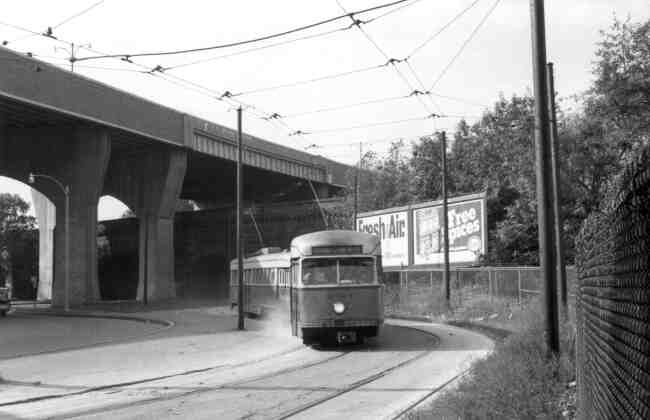
Trolley # 3034 winds its way towards the Forest Hills rotary in this 1960s photo. The Arborway overpass towers over the landscape.

Trolley # 3056 winds its way onto South Street and the Arborway near St. Mark Street in this 1960s era photo.

Trolley # 3219 travels on Centre Street near Spring Park Ave. on its way to Park Street station in this 1970s photo.

Boston Elevated snow plow # 3244 clears the tracks on Washington Street at the Arborway in this 1938 photo. Automobiles can be seen at the Forest Hills rotary.
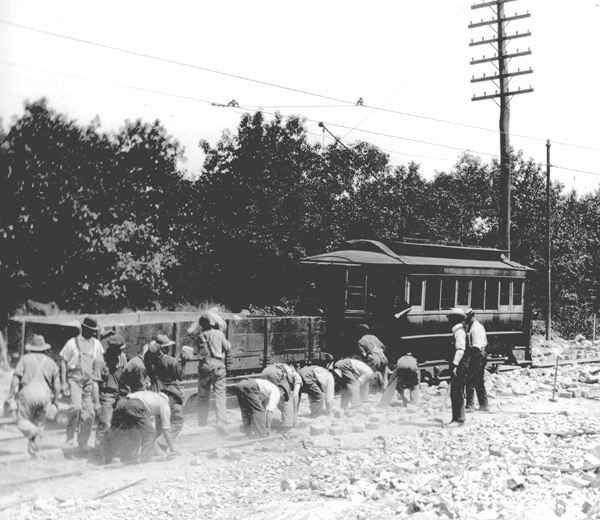
Workers removing paving stones from track bed during maintenance work in West Roxbury ca. 1897.

Taken at the intersection of Washington Street and Brookley Road.
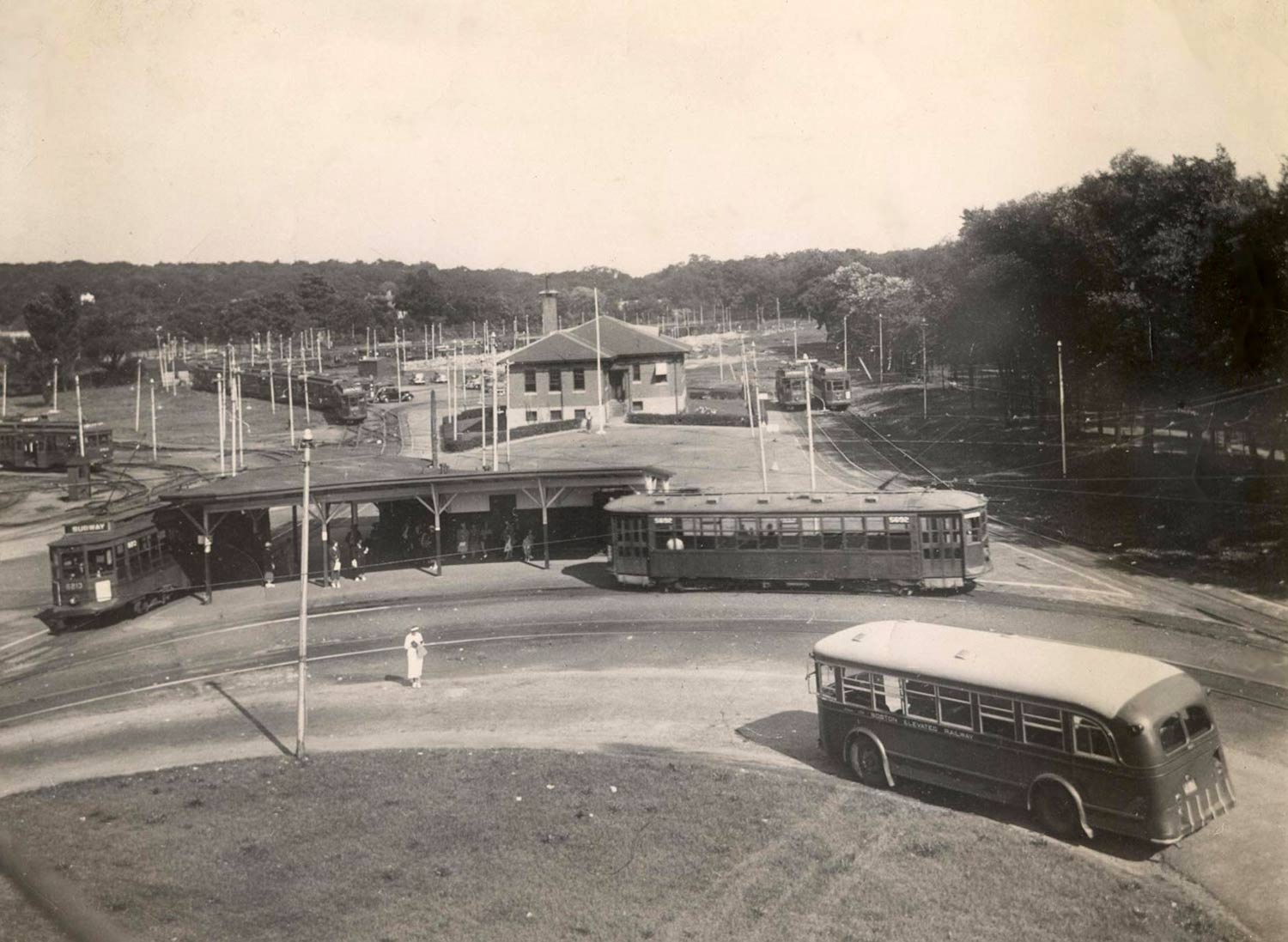
Arborway Yard. Corner of Washinton and Morton Streets. September 7, 1937.
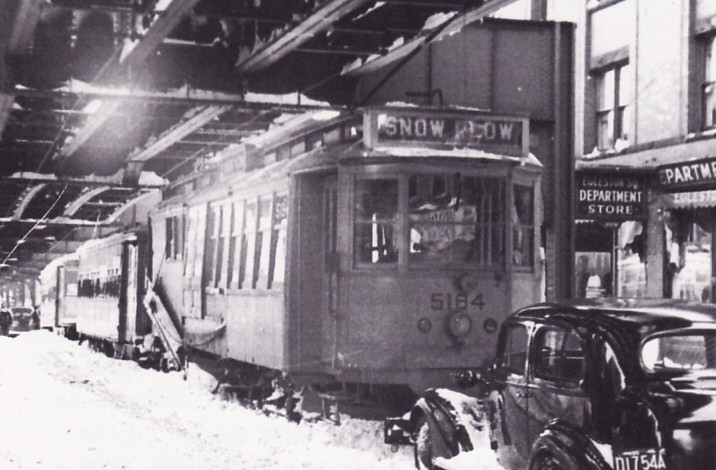
This 1940 photograph shows a snow plow on Washington St. and to the right is shown Egleston Square Department Store.
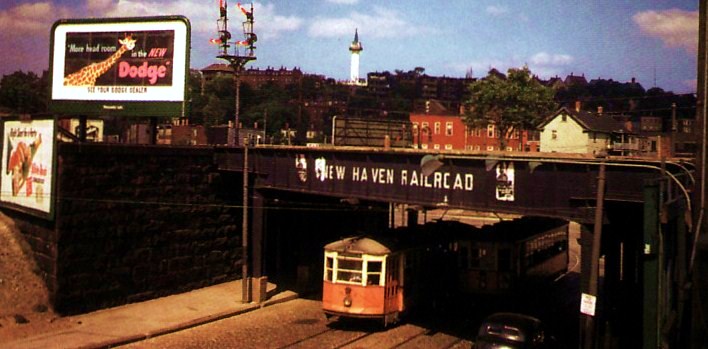
This 1947 photograph shows a trolley passing in each direction on Centre St. under the railroad bridge at Jackson Square. The standpipe on Fort Hill can be seen in the background.

The Arborway Yard during the 1940s.

Forest Hills Station. 1948.

A New Haven Railroad train passes along Forest Hills Station in 1964.

Arborway Station, 1964

Green Street Station, 1964

Arborway Station, February 1964

Next to the Toll Gate Bridge, the southernmost end of the Elevated. This spot abutts a Civil War era Cemetery, the Toll Gate Cemetery, which is still there. A runaway set of cars went right through the bridge at this location after knocking down a bumper post, entering the cemetery, in the early 1900’s. Photograph provided courtesy of Paul Joyce. Copyright © Paul Joyce.
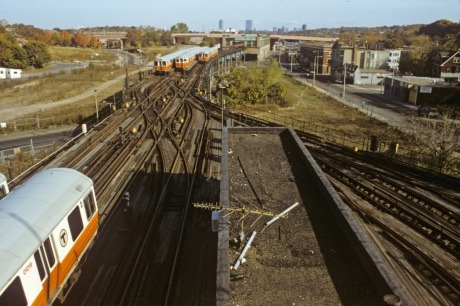
Looking outside the window at Tower H, the Forest Hills Yard and Forest Hills Station is seen in the distance. Looking at Washington Street below, note the reconfiguration has already taken place leading into Forest Hills Square. Photograph provided courtesy of Paul Joyce. Copyright © Paul Joyce.
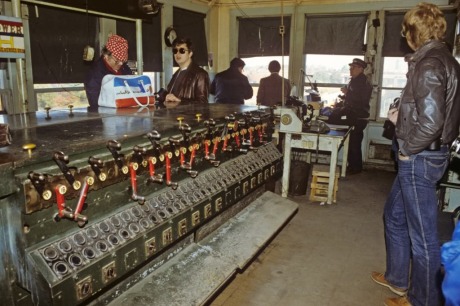
This view is inside Tower H now, with it’s array of switch controls. The view was incredible; the tower was accessed up a long, thin set of winding metal stairs beginning underneath in the lower Walk Hill storage yard. Tower Street, located just off to the east, was perhaps named after Tower H. These shots must have been taken in early Fall as colors appear on the trees towards the Arboretum through the tower’s window. Photograph provided courtesy of Paul Joyce. Copyright © Paul Joyce.

The original Forest Hills Station. Photograph provided courtesy of Paul Joyce. Copyright © Paul Joyce.
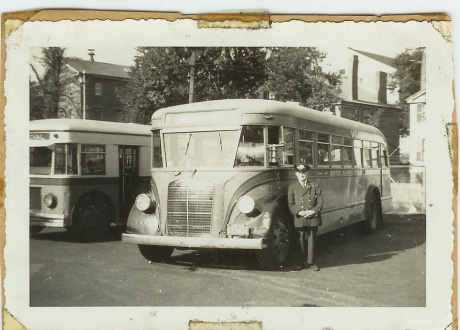
Photograph courtesy of Marilyn Moody who writes: “Here is an photo of my grandfather, George D. Coffen. His nickname was Rooster.”

South Street near Rosemary St. Courtesy City of Boston Archive.
Download

On Thursday, April 30, 1987, Boston's last Orange Line elevated rapid transit rail trains rumbled over Washington Street to their final stop at Forest Hills Station. Photograph by Albert Bussewitz, courtesy of Bob Bussewitz. Albert retired after a long career with the Massachusetts Audubon Society and was a volunteer tour guide for the Arnold Arboretum for many years. The two women on the platform from right to left are the photographer's wife, Flora Bussewitz, and his daughter, Bette Anne Bussewitz. Download

On Thursday, April 30, 1987, Boston's last Orange Line elevated rapid transit rail trains rumbled over Washington Street to their final stop at Forest Hills Station. Photograph by Albert Bussewitz, courtesy of Bob Bussewitz. Albert retired after a long career with the Massachusetts Audubon Society and was a volunteer tour guide for the Arnold Arboretum for many years. Download

On Thursday, April 30, 1987, Boston's last Orange Line elevated rapid transit rail trains rumbled over Washington Street to their final stop at Forest Hills Station. Photograph by Albert Bussewitz, courtesy of Bob Bussewitz. Albert retired after a long career with the Massachusetts Audubon Society and was a volunteer tour guide for the Arnold Arboretum for many years. Download

A trolley passes in front of the Loring-Greenough House on South St.

E Line Trolley at South Huntington & Heath Street, May 1992. Courtesy of Digital Commonwealth, full res version can be downloaded here










































































































































